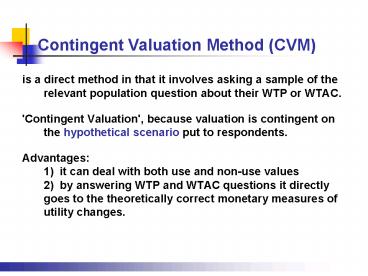Contingent Valuation Method CVM - PowerPoint PPT Presentation
1 / 12
Title:
Contingent Valuation Method CVM
Description:
Referendum choice: Are you willing to pay X? for different X, to many people ... For public goods, referenda and taxes are perhaps best; for (quasi-)private ... – PowerPoint PPT presentation
Number of Views:771
Avg rating:3.0/5.0
Title: Contingent Valuation Method CVM
1
Contingent Valuation Method (CVM)
- is a direct method in that it involves asking a
sample of the relevant population question about
their WTP or WTAC. - 'Contingent Valuation', because valuation is
contingent on the hypothetical scenario put to
respondents. - Advantages1) it can deal with both use and
non-use values2) by answering WTP and WTAC
questions it directly goes to the theoretically
correct monetary measures of utility changes.
2
Contingent Valuation STEPS
- 1) Creating a survey instrument for the
elicitation of individuals' WTP/WTAC. (a)
designing the hypothetical scenario (b)
deciding whether to ask about WTP or WTAC, (c)
creating a scenario about the means of payment or
compensation. - 2) Using the survey instrument with a sample of
the population of interest.
3
Contingent Valuation STEPS -2
- 3) Analysing the responses to the survey. (a)
using the sample data WTP/WTAC to estimate
average WTP/WTAC for the population, (b)
assessing the survey results so as to judge
the accuracy of this estimate. - 4) Computing total WTP/WATC for the population of
interest for use in a CBA. - 5) Conducting sensitivity analysis.
4
Contingent Valuation
- Revealed preference methods (TCM, Hedonic Prices)
can only estimate the use value of the
environment, and only if that value affects
behaviour in a measurable and interpretable
manner - For the rest, we have to use either hypothetical
markets or experimental markets (together
constructed) - Experimental markets have delivered little
estimates (but a lot of insights), so the
contingent valuation method remains this is a
stated preference method.
5
Example
- A Interviewer introduction
- B Background
- 1. Opinion about current tap water quality
- 2. Measures to improve water quality
- C Value of water quality
- Describe major pollution accident in 1991
- If no action, how likely is a repetition?
- Describe pollution prevention system
- How much are you willing to pay?
- D Socio-economic characteristics
6
Define market scenario
- What is being valued? A day at the beach, a view
of the beach? Pollution of a single beach, or all
beaches? - What is being valued, a policy intervention or a
change in pollution these have to be plausible
and comprehensible - What is the payment vehicle? A tax, an entrance
fee, a levy on parking note that people have
opinions on these.
7
Choose elicitation method
- Direct question How much are you willing to pay?
- Bidding game Are you willing to pay X? If yes,
Xd? If no, X-d? - Payment card Choose from a list of numbers,
including comparisons - Referendum choice Are you willing to pay X? for
different X, to many people - (Note we are looking for the maximum amount of
WTP, or the minimum of WTAC)
8
Administration Sample
- Mail No feedback or clarification possible
- Telephone Has to be simple and short, no
graphical material - In-person Expensive, interviewer bias
- Are the people approached a representative
sample? And those who answered? Does the survey
itself induce a bias, for example, in knowledge?
9
Experiment Estimation
- If one hypothesizes a relationship between WTP
and income, then the suggested values (payment
card, bidding game, referendum) have to be
independent of income - If one hypothesizes a relationship between WTP
and political colour, then one should include a
question about the interviewees political
opinions - But sample sizes need to be small, and interviews
short!
10
Validity
- Content (face) validity Does what is measured
and what is supposed to be measured coincide? - Criterion validity Do the measured values
correspond to other measurements of the same
thing? - Construct/convergent validity Do the measured
values correlate to measurements of similar
things? - Construct/theoretical validity Do the
measurements correspond to predictions?
11
Reliability
- The more familiar people are with the good and
the scale, the more reliable the measured values - For public goods, referenda and taxes are perhaps
best for (quasi-)private goods, individual
questions and entrance fee may be better - The payment vehicle may distort the measure.
- Payment cards and perhaps bidding games give the
most reliable results
12
Potential Biases
- Incentive
- Strategic
- Compliance
- Implied value
- Starting point
- Range
- Relational
- Importance
- Position
- Misspecification
- Theoretical
- Amenity
- Context

